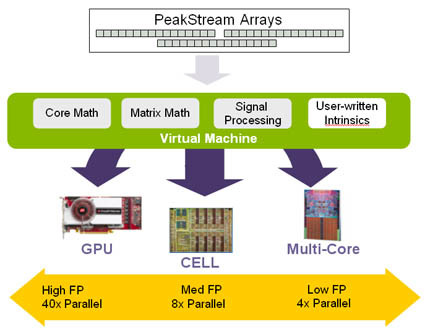The hidden potential in your graphics card: A supercomputer?
Redwood City (CA) - The most powerful computing device in your PC may not be that dual-core processor, but your average graphics card. Interest in tapping the hidden processing power in graphics processor has been growing over the past two years, but Peakstream is the first company to actually offer a solution to create a supercomputer based on graphics cards.
Peakstream claims that it has developed a new software platform that can create supercomputers by combining the processing capability of common CPUs with the resources of modern graphics cards. Simply by adding the horsepower of graphics cards to an existing computer, the company claims that the original system can be accelerated by a factor of 20x.
Compared to graphics processors, main system processors have developed much slower in providing an increase in floating point performance. For example, a Pentium 4 3 GHz processor was estimated to reach about 6 GFLOPs (billion operations per second), while Woodcrest, the server variant of Intel's Core 2 Duo processor, is currently believed to top out at around 24 GFLOPs; according to Intel, a four-processor dual-core Itanium 2 system recently reached 45 GFLOPs.
At least in the floating point discipline, graphics chips are way ahead of the game: ATI recently said that its current high-end X1950 XTX processor brings in 375 GFLOPs, in dual-graphics mode even up to 750 GFLOPs - the equivalent of 31 Xeon 5100 processors. Nvidia's Geforce 7950 GX2 dual-GPU card is rated at 384 GFLOPs and Ageia's physics processor at 96 GFLOPs.
There have been several advances to take advantage of the floating point performance of the GPU when it isn't completely consumed by a video game. For example, Nvidia announced earlier this year to enable physics processing in dual-GPU SLI configurations; ATI calls this process load balancing and talked about opening up the hardware platform to allow software developers to access excess performance capability in graphics cards. Independent projects included BionicFX, which developed a technology to use graphics cards for accelerated audio processing.
Peakstream employs a similar concept and provides software developers an interface to take advantage of graphics cards. The firm's C and C++ based application interface and virtual machine handles work scheduling and memory management and a way for programmers to easily access a combined system of processors - such as x86 or Cell chips - and graphics cards. According to Peakstream, the system can be used with standard developer tools such as Microsoft's Visual Studio or Intel's Compiler software and requires only a "minimal learning curve." The platform is also able to run on unmodified Windows and Linux operating system, the firm said.
Peakstream's platform model
Get Tom's Hardware's best news and in-depth reviews, straight to your inbox.
Theoretically, the platform would allow anyone with some programming experience to build a small supercomputer at home. However, the fact that the performance is floating-point focused, Peakstream is aiming for customers in the traditional supercomputing market. The firm believes that especially applications in oil and gas, financial services, defense and academia will be interested in the solution. The company promises that its platform can provide performance increases in industry specific benchmarks between 16x (Monte Carlo Simulation) and 21x (Kirchhoff Migration) over CPU-only systems.
Price may be the main component that will keep private users from taking advantage of the Peakstream platform. The company charges $2000 per computing node for its software, but mentioned that it will provide volume discounts for large cluster systems.
Tom's Hardware is the leading destination for hardcore computer enthusiasts. We cover everything from processors to 3D printers, single-board computers, SSDs and high-end gaming rigs, empowering readers to make the most of the tech they love, keep up on the latest developments and buy the right gear. Our staff has more than 100 years of combined experience covering news, solving tech problems and reviewing components and systems.

